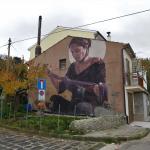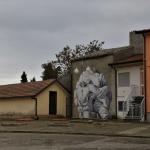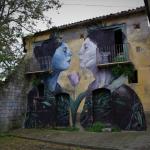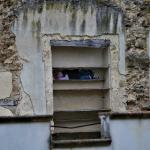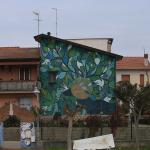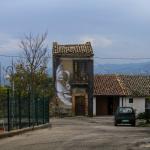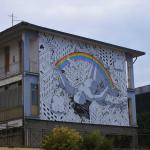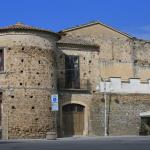The Municipality of Bonito is located in the Ufita Valley area. It's a town of 2,404 inhabitants, located 490 meters above sea level and 40 km from Avellino. The territory extends for 18.78 sq km and the adjoining municipalities are: Apice, Grottaminarda, Melito Irpino and Mirabella Eclano. It is crossed by the Ufita river.
The etymology of the name seems to come from the Latin noun Bonetum, "fortification in the shape of a priest's cap", or from the medieval name Bonitus. However, the most accredited thesis is that it took its name from the homonymous feudal lords. The inhabitants are called Bonitesi and Saint Bonitus of Clermont is their patron saint.
PLACES OF INTEREST
- Norman Castle - Of the small square-plan castle, built around 1130, only a Norman tower, namely Torre Maluocchi remains
- Pagella-Buongiorno Palace - Dating back to the 18th century, it was initially owned by the Capozzi family
- Church and former Convent of Sant'Antonio (Saint Anthony) - That of the Convent is a construction begun in 1712 which, for a period, was used as an infirmary, while the Church, with a single nave, became a cemetery from 1839 to 1849
- Church of San Giuseppe (Saint Joseph) - Built during the first demographic development of the town, it houses an ancient statue of Saint Peter
- Church of the Assunta (Our Lady of the Assumption) - Inside valuable works of art are preserved, such as the painting of the Annunciation
- Vincenzo Camuso Chapel - Also known as the "Congregation of Good Death", it houses the mummy of a mysterious person revered by the Bonito inhabitants
- Sanctuary of Maria SS. della Neve (Our Lady of the Snow) - Recent sanctuary that stands on the place where, according to tradition, at the end of the 6th century a sweet female figure identified as the Madonna appeared
- Church of San Domenico (Saint Dominic) - The Congregation of the Holy Rosary was officially established in this church, called S. Domenico, on the first Sunday of October 1867
- Murals - Street art works created by internationally renowned artists on free walls of buildings in the town, intended to enhance the urban and rural context
- Permanent exhibition "Looking for lost things" - Created by Gaetano Di Vito, it presents many objects of common use, but also rare and particular objects, some really unobtainable; it is also known as the "Museum of peasant civilization, arts and crafts"
EVENTS
- Fusillo and Spezzatino Festival - Summer food and wine event, which takes place in the first days of July in Morroni, dedicated to the ancient flavours of Irpinia
- Bonito for Doctors Without Borders - Charitable initiative in favour of Doctors Without Borders
- Feast of Saint Bonitus - Celebrations in honour of the patron saint which take place on January 15th
- Good Friday - Procession with the Dead Jesus on the Friday preceding Easter
- Our Lady of Sorrow Procession - Procession that takes place on the last Sunday of September
- Bonfire Night - In honour of the Immaculate Virgin, it takes place on the 8th of December
- Feast of Saint Roch - Celebrations that take place on the 16th of August
- Feast of Our Lady of the Assumption - Celebrations in honour of the Assumption of the Virgin Mary on the 15th of August
- Feast of Saint Anthony - Celebrations in honour of Saint Anthony on the 13th of June
- Feast of Saint Crescentius the Martyr - Celebrations that take place on the first Sunday of August
- Feast of Our Lady of the Snow - Celebrations that take place on the 4th and 5th of August
- Pizza festival - It takes place on the 6th and 7th of August with music, fun and lots of good pizza
- Saint Patrick’s Day - Gastronomic event, sponsored by the Saint Patrick's Day association, dedicated to music, entertainment, folklore, food and beer
TYPICAL FOOD AND PRODUCTS
- Taurasi DOCG - Wine of great tradition, made thanks to a very ancient grape variety: well structured, elegant and austere but at the same time balanced and tannic; suitable for very long ageing also thanks to its structure, minerality, good alcohol content and fullness
- Irpinia Colline dell'Ufita PDO - Extra virgin olive oil deriving largely from the Ravece variety, characterized by a pleasant bitter and spicy taste
- Sant'Anna Pear PAT - Fruit with a delicious sugary flavour, yellow in colour, it has small red spots in the parts most exposed to the sun
- Spina Pear PAT - Similar to Sant'Anna, it is distinguished due to its smaller size
- Cuccio co’ l’uovo - Chopped rabbit with eggs, cheese, garlic, pepper and parsley
- Cecatielle co’ lo pulieio - Pulieio, "puleggio" in Italian, is a kind of wild mint used to season fresh cavatelli
- L’acciaccata - Mix of crushed basil, fresh peppers, garlic and hot red pepper
- Menesta ‘mmaretata - Escarole and beans, possibly cooked in an earthenware container (called pignata or pignatiello), joined ('mmaretati) with poor cuts of the pig, i.e. legs, ears, snout, poor sausage
- Cecole di puorco co’ peparule al’acito - Sautéed pork and pieces of pepper in vinegar, blended with white wine
- Peparule chine - Round red peppers in vinegar with stale bread crumbs, cooked wine, raisins, walnuts and pine nuts
- Pizza ionna - The "blonde pizza" is made from corn flour, olive oil and pork cracklings (frittole)
- Menesta asciatizza sfritta - Basis of the dish are cardoncello (cardusciello), borage (orràina), wild chard (éta), wild chicory and other spontaneous vegetables
FUN FACTS
Salvatore Ferragamo (1898-1960), today one of the most important and internationally known Italian brands in the world of luxury fashion, was originally from Bonito, just like his wife Wanda Miletti (1921-2018).
According to a legend, during the anti-Spanish revolt of Masaniello in 1647, a member of the historic Pisaniello family was beheaded for having kidnapped a local girl and kept her prisoner in his castle.
HISTORICAL NOTES
The history of Bonito is certainly very old. In the Roman age we have evidence that it was part of the territories of the ancient Aeclanum, intensively cultivated by the settlers.
The first news relating to the existence of an inhabited centre, however, dates back to the 10th century, when the Castrum Boneti was built by the Lombards for defensive purposes in the border area between the county of Ariano and the Duchy of Benevento.
In the following century the fief passed to the Normans and in the Angevin period to the local Bonito family. Then it became property of the Orsini in 1445, of the Pisaniello in 1647, it returned to the Bonito in 1674 and it was annexed, under the Bourbons, in 1757, to the royal property .
Some of the best museums in the world are the streets and Bonito is one new place to take a Street Art Tour. Explore how artists express their creativity and come home with an inspirational luggage
Bonito
Largo Mario Gemma, 15, 83032 Bonito AV, Italia
Events
-
Charity initiative in favour of Doctors Without Borders
-
Summer food and wine event dedicated to the ancient flavours of Irpinia
Featured places
Via Belvedere, 83032 Bonito AV, Italia
More correctly known as the Congregation of Buona Morte, it houses the mummy of a mysterious…
Via Roma, 83032 Bonito AV, Italia
Built during the first demographic development of the town, it houses an ancient statue of…
Via Roma, 83032, Bonito AV, Italia
Inside, there are valuable works of art such as the painting of the Annunciation
Via Morroni, 83032 Bonito AV, Italia
A recent sanctuary that stands on the site where, according to tradition, a sweet female…
Largo Mario Gemma, 83032 Bonito AV, Italia
All that remains of the small castle dating from around 1130 is the Norman Tower, awaiting…
Vico Masaniello, 5, 83032 Bonito AV, Italia
Created by Gaetano Di Vito, it presents many objects of common use, but also rare and…
Did you like it? Leave a review
Your opinion is important! It will be visible after approval by the editorial staff.
To post a comment you must be an authenticated user. Log in with Social Login
